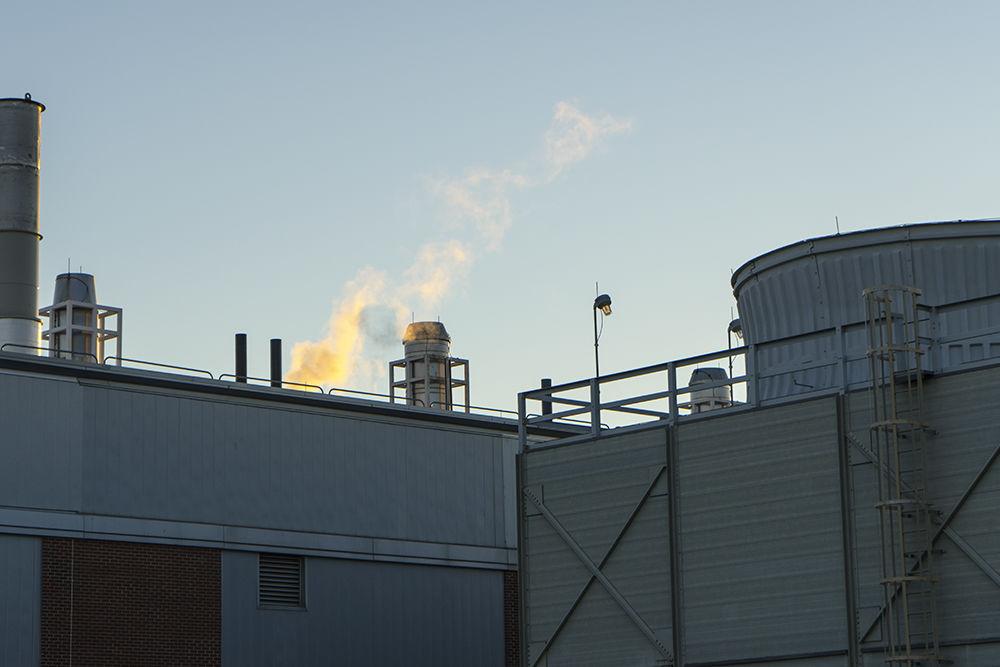
Dan Gilliam
Steam rises out of the Centennial Campus Central Utility Plant. The facility provides electricity and steam for Centennial Campus.
A new generator on Centennial Campus has recently been installed, increasing energy efficiency and cutting down on dependence on outside energy.
The Centennial Campus Central Utility Plant contains the new generator, which is expected to cut down on NC State’s greenhouse gas emissions by 4 percent overall.
Cameron Smith, senior director of Capital Project Management, spoke about the new generator and described the process of cogeneration, also known as combined heat and power.
“We [installed] a combustion turbine generator that creates electricity,” Smith said. “As we create that electricity for campus, there’s a byproduct of heat that comes off that turbine. We use that waste heat to create steam. We use the steam, obviously, to provide heating on campus, and so it’s very, very efficient.”
Smith also said that since NC State is creating its own electricity on Centennial Campus, it doesn’t have to pay Duke Energy as much for power. NC State now generates about a third of its own electricity, according to Smith.
According to Alan Daeke, the director of Utility and Engineering Services, a part of the Energy Systems Department in NC State Facilities, the efficiency of traditional power plants is lower than NC State’s combined heat and power generators.
“The overall efficiency is about 78 percent, compared to 38 percent for a typical power plant,” Daeke said.
This generator provides power to all of the NC State-owned buildings on Centennial Campus and provides steam for heating to many of them, as well, according to Daeke.
“We ended up funding $17 million of the project through energy savings,” Daeke said. “So that’s $17 million that is not a capital request of the university.”
Daeke commented on how the new turbine plays into the university’s sustainability goals.
“Sustainability has got a lot of different facets to the plan,” Daeke said. “The piece that this supports and contributes to is our greenhouse gas reductions. We’re projected that this project will reduce the university’s greenhouse gas emissions by 4 percent.”
Daeke also discussed the energy reduction goals on campus, which are based on data from 2002.
“We wanted to reduce our energy usage by 33 percent on a square-foot basis, and we’ve reached that,” Deake said. “Our new challenge is we want to get to 40 percent reduction compared to 2002.”
Daeke said that engineering students have toured the facility.
“Cogeneration has been around for a long time, but by getting students exposed to this — they’re going to be going out into the world, they’re our future problem solvers,” Daeke said. “Getting them familiar with this type of technology and the benefits of it gives them a good tool to go forth and solve the challenges that we’re really facing today, with technology that we haven’t even thought of.”
Daeke commented about further sustainability efforts from the university.
“We’re gearing up to replace our street lights with LEDs,” Daeke said. “So we’re getting rid of the old metal halides and high-pressure sodiums and going to LED lights … So that’s going to reduce our electrical usage.”
Students will see the light fixtures change in the coming months, according to Daeke.
Daeke also said that options for using solar power on campus are currently being explored by Energy Systems, but that no projects are currently underway.
He made a final statement about what can be done to improve energy efficiency on campus.
“There’s not one thing we can do — it’s a multitude of things we can do,” Daeke said. “Everybody doing a little bit will move the needle more than one person trying to do one big thing.”
“An interactive diagram of Main Campus’ cogeneration explaining the different steps and how it works is available online.